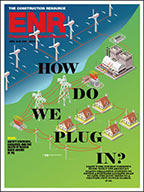Construction Spending Rebounds in April as Stimulus, Residential Drive Demand
Construction spending rebounded strongly in April, with an increase of 2.7% or $23 billion from March to a seasonally adjusted annual rate of $869 billion according to the latest analysis of federal spending figures released by the Associated General Contractors of America.
The association notes that the gains were primarily driven by private residential construction (up 4.4%) and public construction (up 2.4%), but that private nonresidential also increased significantly (up 1.7%).
“The stimulus is clearly driving one of the biggest increases in construction spending the industry has experienced in a long time,” says Ken Simonson, chief economist for the construction trade association. “Once you look beyond the stimulus, however, these figures show how uneven and fragile the construction recovery remains.”
Simonson notes that the stimulus drove significant increases in a range of public construction categories. For example, compared to March 2010, spending on public drinking water supply facilities jumped 7.9%; public sewage treatment, 3.9%; and highway construction 3.6%.
Spending on other public transportation modes was flat for the month but soared 29% compared to April 2009. In contrast, public educational construction spending, which received little stimulus support, only edged up 0.4% for the month and was 18% lower than a year earlier.
Private nonresidential spending was boosted by strong gains in private power construction ($3.9 billion, 5.2% for the month); manufacturing ($1.5 billion, 2.7%); and communication ($1.3 billion, 7.3%).
Meanwhile, developer-financed categories, which are plagued by high-vacancy rates and tight credit conditions, continued to tumble. Private lodging construction rose 0.8% for the month but was down 61% compared to April 2009; commercial (retail, warehouse and farm) was down 2.9% and 37%; and private office was down 1.7% for the month and 36% for the year.
Private residential construction figures were also mixed, says Simonson. New single-family construction climbed 3.4% for the month and 29% year-over-year, and improvements to existing single- and multi-unit construction rose 6.3% and 4% from a year earlier. But new multi-family construction—condos and rental buildings, which are developer-financed —slumped 1.9% in April and 57% compared to a year ago.
“Assuming the economy continues to expand, privately-funded construction should experience a rebound starting in 2011,” Simonson notes. “But for now stimulus funding remains the main source of support for nonresidential contractors.”
Commenting on the new federal data, William E. Davis, executive vice president of the Southern California Contractors Association, says that much of the increase in the heavy construction side this past month came from local stimulus-funded highway projects in Northern California. In Southern California the heavy construction economy got a big boost from the non-stimulus $270 million desalination plant in San Diego County and a $75 million windmill job in Kern County.
Davis says that according to the Construction Industry Research Board (CIRB), public works activity was up 50.3% from March and up 28.1% from April 2009. All of the upward movement came from the heavy construction sector which was up an “astonishing” 150.2% from March and 48.7% from April of 2009.
“All of this good news begs the question ‘up from what?’” says Davis. “California's market peaked in 2005, according to CIRB, with $95 billion in activity, fueled by the housing market. The recovery this year is driven by broad-based, double-digit upticks in all the market sectors, including housing, but is forecast to only reach $40.6 billion in total.”
Davis says highway construction is actually lagging this year so far, partly because Caltrans was very aggressive last year in pumping $936 million in stimulus funding into the marketplace.
“We think there is an opportunity for things to get much better in highway work, if the state can figure out its budget,” Davis adds. “In late March the legislature passed and the governor signed the gas-tax swap proposal. It will go into effect July 1 and give California a clear funding source to underwrite some of the $15 billion in Prop 1B bonds that remain unsold.”
Regarding jobs, Davis says California construction employment, according to newly revised figures, peaked in February 2006 at 948,500. According to the Employment Development Department's April 2010 report that number now stands at 553,800, resulting in a 42% unemployment rate in the industry.
“If, during this election season, you happen to bump into a candidate for state or local office, you might mention this little problem and ask them what they are doing about it,” says Davis.

